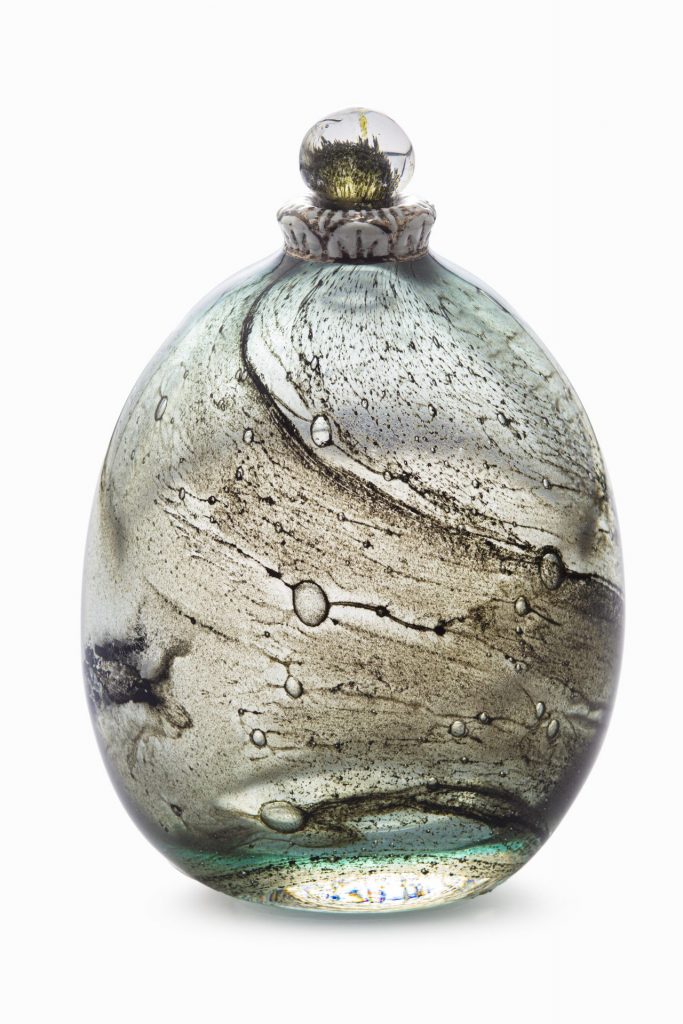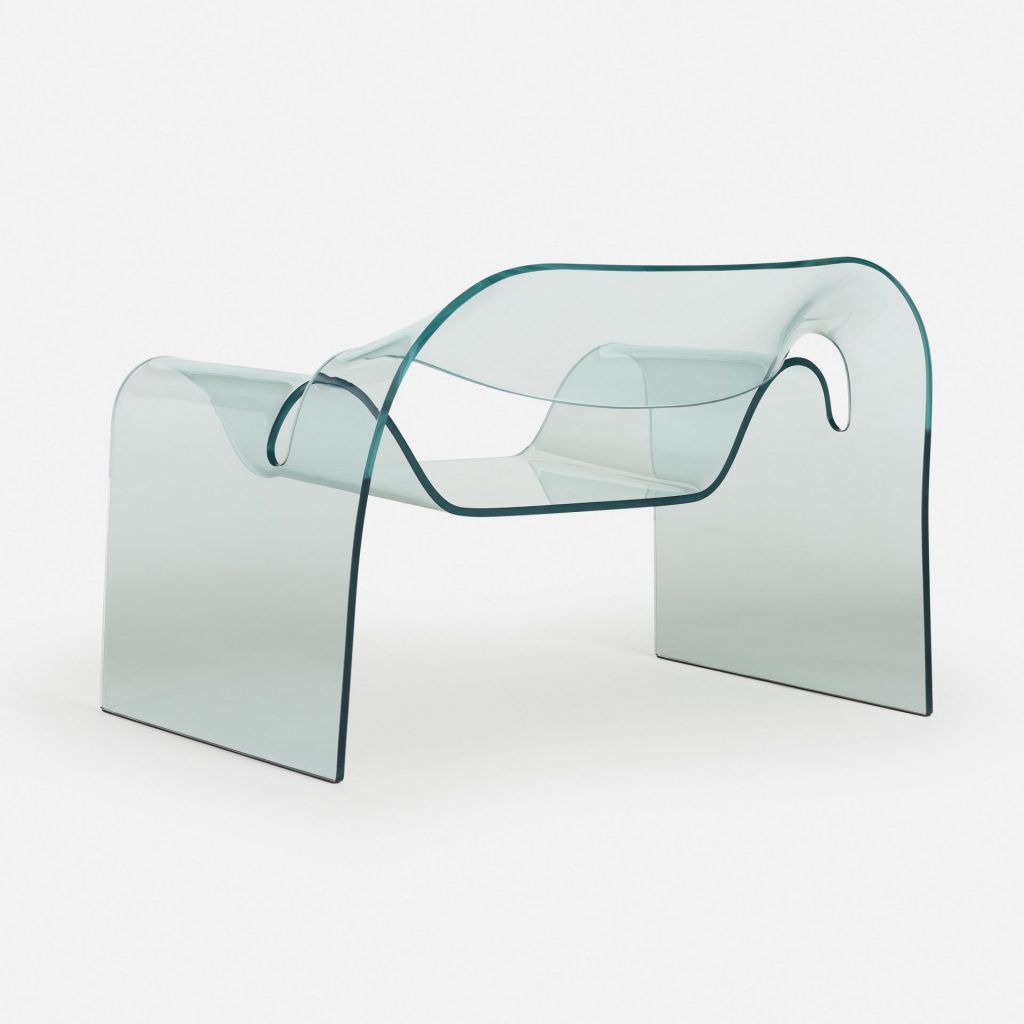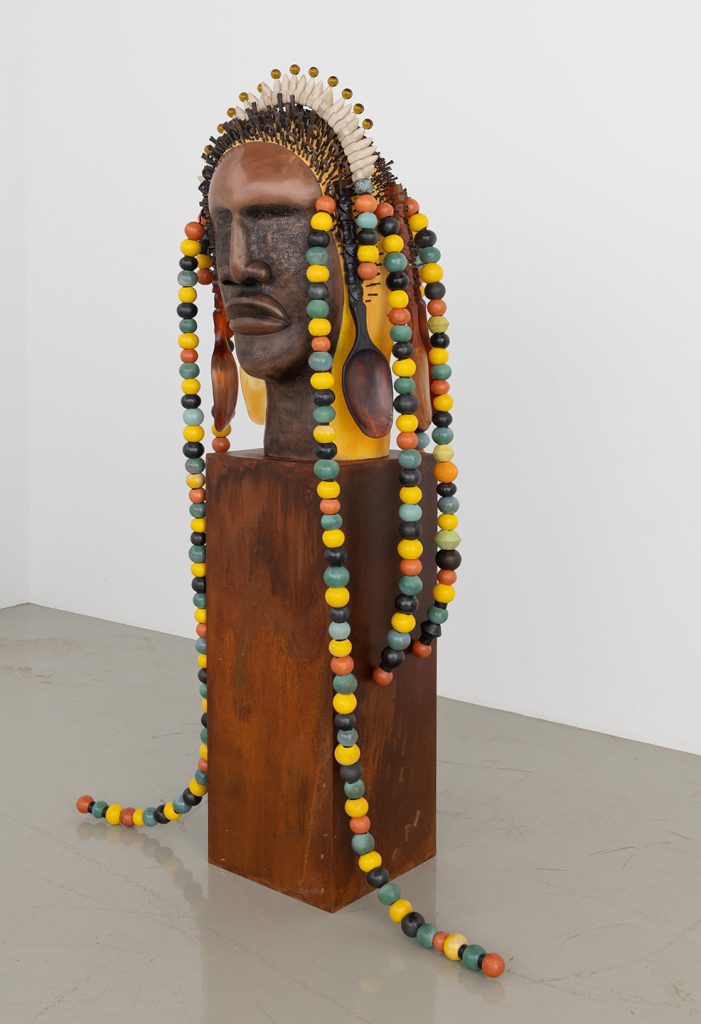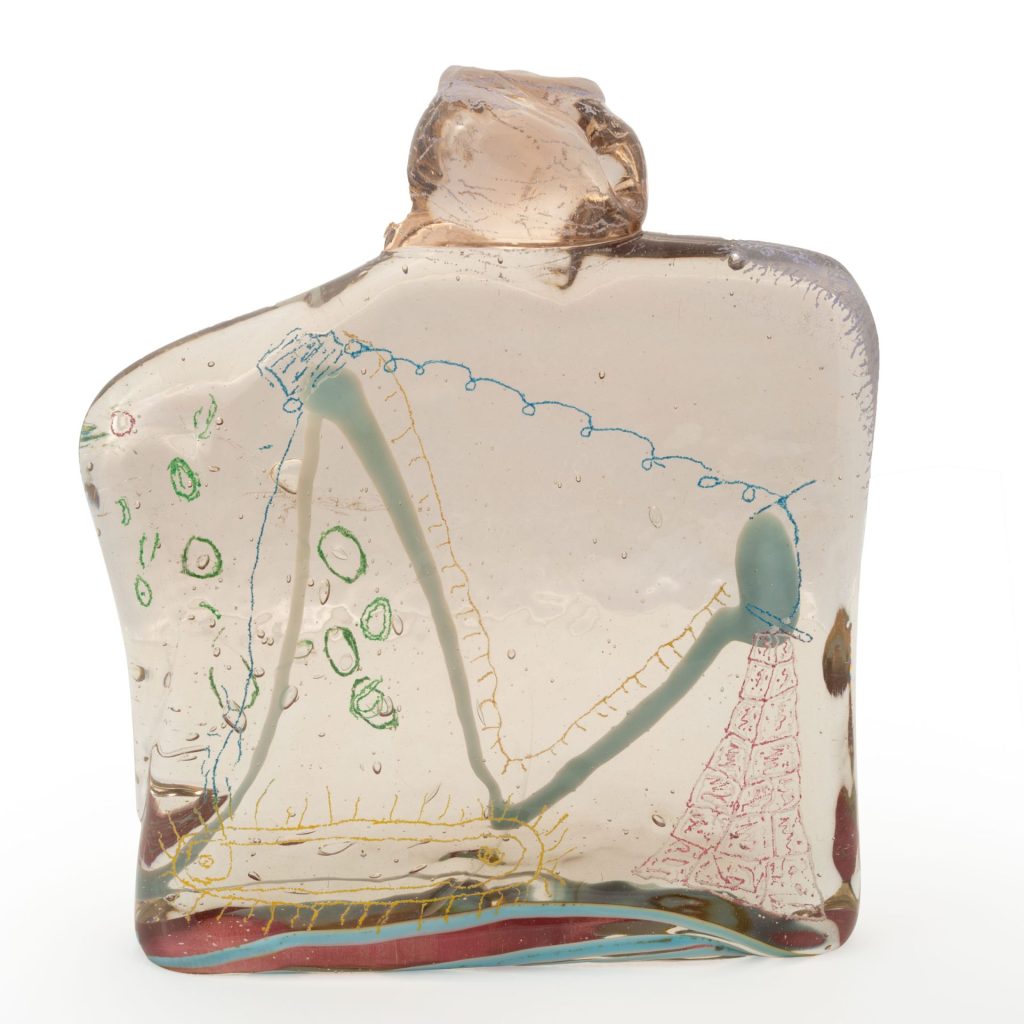
Maurice Marinot (French, 1882–1960), Bottle, c.1926. Blown glass; 6 3/4 in. NOMA, Museum purchase, William McDonald Boles and Eva Carol Boles Fund, 2004.40.a,.b © Merat Troyes
UPCOMING EXHIBITION AT NOMA LOOKS AT ARTISTIC INNOVATION IN GLASS OVER 4,000 YEARS
Opening Friday, August 30, Sand, Ash, Heat: Glass at the New Orleans Museum of Art is drawn entirely from the museum’s permanent collection.
The exhibition presents a variety of perspectives on how glass is connected to histories of scientific discovery, foodways, cultural exchange, and artistic innovation across time and cultures.
Objects on view range from ancient vessels and Venetian glass to examples of the 20th-century American studio craft movement and newly acquired works by contemporary artists including Fred Wilson and Sharif Bey.
NEW ORLEANS – Beginning this month, the New Orleans Museum of Art (NOMA) presents the first ever comprehensive look at the institution’s extensive collection of glass objects ranging from tiny ancient Egyptian amulets to large-scale works of contemporary sculpture. Opening Friday, August 30, Sand, Ash, Heat: Glass at the New Orleans Museum of Art explores how a common material has inspired innovation in the arts and sciences for millennia. The exhibition is on view in NOMA’s Ella West Freeman Galleries through February 10, 2025.
Featuring an expansive range of objects drawn entirely from NOMA’s exceptional glass collection, the exhibition showcases a diversity of work to foreground how glass is connected to histories of scientific discovery, foodways, cultural exchange, and artistic innovation.
“A comprehensive historic glass collection comprises one of the hallmark areas of NOMA’s important holdings in decorative arts and design. Sand, Ash, Heat proposes a unique interpretive lens to consider these objects alongside works in other parts of NOMA’s collection,” said Susan M. Taylor, The Montine McDaniel Freeman Director of NOMA. “The exhibition demonstrates how we might use one ubiquitous material as a case study to examine a much broader history of human creativity across time and place.”
The history of glass is ultimately a history of art, culture, technology, and science. Sand, Ash, Heat highlights glass artistry and production across a span of over 4,000 years, exploring glass as a vehicle for the transfer of ideas around the world and tracing innovation in manufacture and artistic expression in this important medium.

Cini Boeri, designer (Italian, 1924–2020), with Tomu Katayanagi (Japanese, active Italy, b. 1950), for FIAM Italia, manufacturer (Italy, founded 1973), “Ghost” Chair, 1987 design. Tempered glass, 27 ¾ x 37 x 30 in. NOMA, Museum Purchase, William McDonald Boles and Eva Carol Boles Fund, 2023.23 © Cini Boeri. Image courtesy of Rago/Wright.
In presenting a broad look at glass from prehistory to present day, Sand, Ash, Heat highlights celebrated traditions of glass alongside new perspectives on the material.
The exhibition includes a focus on the legacy of glass-making on the Venetian island of Murano, which since the 13th century has been at the center of a broad network of international glass exchange. With a debt to ancient Roman glass and to technologies perfected in Syria and Egypt, Venetian glass set the European standard for fine tableware emulated by glassmakers around the world.
Sand, Ash, Heat also features standout examples of “art glass” from the late 19th and early 20th centuries, when artists began to look at glass in a new way. At that time, makers shifted from considering the function and decoration of glass to manipulating the material’s color and form to express ideas and artistic visions. Examples from Louis Comfort Tiffany, René Lalique, the Wiener Werkstätte, and others show how glass was an important part of the Art Nouveau style, the Arts and Crafts Movement, and other artistic advances of the late 19th and early 20th centuries.
Additionally, key figures in the 20th-century American studio craft movement from New Orleans and beyond demonstrate how artist communities formed around glassmaking. Sand, Ash, Heat features former students and professors of Tulane University, including Gene Koss, Deborah Czeresko, and Mitchell Gaudet—underscoring the importance of the hot shop founded by Koss in 1976. And works by modern and contemporary artists, including Christopher Wilmarth, Lynda Benglis, and Olafur Eliasson, demonstrate the possibilities of glass to convey ideas and effect sensory experiences.
Today, artists continue to reference and update these traditions through their own experiments with glass, including a monumental black glass chandelier by Fred Wilson that highlights worldwide cultural exchange and a new work by Sharif Bey, the latest in a series of commissions inspired by NOMA’s historic holdings in decorative arts and design.
Exploration of glass in modern and contemporary art at NOMA continues outside in the museum’s Sydney and Walda Besthoff Sculpture Garden, where visitors can see large-scale and site-specific art created in glass by Larry Bell, Maya Lin, Jean-Michel Othoniel, and others.

Sharif Bey (American, b. 1974), Domestic: Queen, 2024. Glass, earthenware, metal. New Orleans Museum of Art, Museum purchase, William McDonald Boles and Eva Carol Boles Fund, 2023.24. ©️ Sharif Bey.
“This exhibition shows glass in its full complexity—rare or common, delicate or powerful. At all moments of human artistic and scientific achievement, glass was there,” said Mel Buchanan, NOMA’s RosaMary Curator of Decorative Arts and Design. “Glass lenses improved human sight and allowed us to explore the solar system; advancements in glass architecture can be seen in both Gothic cathedrals and modern skyscrapers; and today’s glass phone screens and glass fiber-optic networks connect our world at a speed we could not have imagined even thirty years ago. Even a modest wine bottle and the glasses used to toast a loved one’s accomplishments are part of that shared human history in glass.”
Sand, Ash, Heat is a significant contribution to understanding and sharing NOMA’s permanent collection, which includes nearly 5,000 works of glass. In the 1950s, railroad executive Melvin P. Billups donated his superb collection to the museum (then known as the Delgado Museum of Art), honoring his wife Clarice Marston Billups in her hometown of New Orleans. The Billups historic glass collection forms the throughline for this exhibition and accompanying catalogue—alongside more recent strategic acquisitions to tell a more complete narrative.
Visitors can expect to see over 250 works of glass art, including:
- Ancient objects from around the world, including what is likely the oldest object in NOMA’s collection—a cast blue glass Ram’s Head from the 18th Dynasty of Egypt (1550–1292 BCE). Also included are examples of early Roman blown glass (100–400 CE), rare Chinese Han Dynasty ear ornaments (202 BCE–220 CE), and a faceted Sasanian Empire bowl (500–700 CE), and a glass cosmetic flask in the shape of a dromedary, or Arabian camel (700–900 CE).
- Glass from various points of innovation in the material, including examples of Venice’s famous featherlight “Cristallo” glass from the 17th century, and a very rare example of George Ravenscroft’s 1674 experiment with making “lead” glass.
- An extraordinary 1920s bottle by Maurice Marinot, who exhibited with the French Fauves before turning to glassmaking in the 1910s. He became one of the first artists to embrace a completely new aesthetic for the medium, making intentionally artistic work that incorporated entrapped bubbles into thick, sturdy vessels that contrasted with the material’s traditional delicacy.
- A “Ghost” chair designed by Cini Boeri, one of the first female designers to rise to prominence after World War II. Molded from a single sheet of half-inch-thick tempered glass, the elegant chair shows how modern makers experimented with form and production methods.
- Works by Gene Koss, who founded the hot shop at Tulane University, and other artists affiliated with the school’s rich history of glass-making, including Deborah Czeresko, winner of season one of Netflix’s Blown Away.
- Glass beadwork, including an example of New Orleans Black Masking Indian traditions. A newly-acquired “Shango” Spyboy Suit by Big Chief Dow M. Edwards of the Timbuktu Warriors is presented alongside works from NOMA’s collections of African and Indigenous art.
- A major 2017 sculpture titled The Way The Moon’s in Love with the Dark Chandelier by Fred Wilson, celebrated for his work that challenges racist assumptions in history, culture, and museums. The seven-foot-tall Murano-style black glass chandelier opens the exhibition with dichotomies between dark and light, metal and glass, floral and geometric, European and Middle Eastern, and history and today.
- Recently commissioned by NOMA, a work by Sharif Bey titled Domestic: Queen continues the artist’s longstanding artistic investigation of regalia, ceremony, and adornment. Inspired by the museum’s galleries and collection—set within a city rich in pageantry traditions—the sculpture draws from the visual heritage of African and Oceanic art, while also probing questions about power dynamics in today’s North American museums.

Gene Koss (American, active New Orleans, b. 1947), Ridge Road Climb, 1984. Cast glass. New Orleans Museum of Art, Gift of Mr. and Mrs. Hugh Kohlmeyer, 86.101. © Gene Koss.
Catalogue
An accompanying 176-page catalogue—Glass: Sand, Ash, Heat—is published by Scala Arts & Heritage Publishers. The volume is available for purchase at the NOMA Museum Shop. The book features texts by Mel Buchanan, NOMA’s RosaMary Curator of Decorative Arts and Design and includes contributions from:
- Black Masking Indian Big Chief Dow M. Edwards of the Timbuktu Warriors with Amanda M. Maples, Françoise Billion Richardson Curator of African Art at NOMA
- Christopher Maxwell, Samuel and M. Patricia Grober Curator in the Department of Applied Arts of Europe at the Art Institute of Chicago
- Laura Ochoa Rincon, Decorative Arts Trust Curatorial Fellow at NOMA
- Zella Palmer, Chair and Director of the Dillard University Ray Charles Program in African-American Material Culture
- Brian Piper, Freeman Family Curator of Photographs, Prints, and Drawings at NOMA
- Alex Sanchez, Chromatography chemist
- Ingrid Seyb, Conservator of Objects at NOMA
Creative Concept Studio
In addition to in-gallery displays that look at the creation, manipulation, and conservation of glass, visitors are invited to explore the material in the museum’s Evelyn L. Burkenroad Creative Concept Studio, where guests will learn more about glass as a multifaceted material in New Orleans. Visitors will be introduced to contemporary artists and organizations working with glass, including Glass Half Full, Mark Rosenbaum of Rosetree Studio, and YAYA Arts Center.
Selected Programming
NOMA is celebrating Sand, Ash, Heat with a free public program on Friday, September 13, 7–9 pm, featuring gallery talks, live music, late-night access to the museum, and more. Advance registration is available on NOMA’s website.
Throughout the run of Sand, Ash, Heat, the museum will present lectures, tours, and other opportunities to explore the exhibition’s themes. Updated programming information is available at noma.org.
Funders and Support
Sand, Ash, Heat: Glass at the New Orleans Museum of Art is sponsored by the Eugenie and Joseph Jones Family Foundation. Additional support is provided by Susanne and David Purvis, the Art Alliance for Contemporary Glass, Harvey and Marie Orth, Robert and Pamela Steeg, Mary Beth & Sheldon Ray, in honor of Bettie Pendley, and Lori and John Solon.
###
Media Contacts
Charlie Tatum
Director of Marketing and Communications
New Orleans Museum of Art
ctatum@noma.org
504.658.4103
Ra’Jae’ Wolf
Marketing and Communications Associate
New Orleans Museum of Art
rwolf@noma.org
504.658.4106
###
About NOMA and the Besthoff Sculpture Garden
The New Orleans Museum of Art (NOMA) and its Sydney and Walda Besthoff Sculpture Garden are home to innovative exhibitions, installations, educational programs, and research. Exploring human creativity across time, cultures, and disciplines, the global scope of the museum’s initiatives open a vibrant dialogue with the history and culture of New Orleans. The museum stewards a collection of nearly 50,000 works, with exceptional holdings in African art, photography, decorative arts, and Japanese art, as well as strengths in American and French art, and an expanding collection highlighting contemporary artists. The museum’s exhibitions and dynamic learning and engagement offerings serve as a forum for visitors to engage with diverse perspectives, share cultural experiences, and foster a life of learning at all ages. Recent exhibitions include Black Orpheus: Jacob Lawrence and the Mbari Club, Called to the Camera: Black American Studio Photographers, The Orléans Collection (an exhibition of forty European masterpieces from the collection of the city’s namesake, Philippe II, Duc d’Orléans), East of the Mississippi: Nineteenth Century America Landscape Photography, and Changing Course: Reflections on New Orleans Histories (seven contemporary art projects focusing on reimagining stories from the city’s past).
NOMA’s 12-acre Sydney and Walda Besthoff Sculpture Garden expands visitors’ experiences of the museum with one of the most notable sculpture gardens in the country. The Besthoff Sculpture Garden, free and open to the public seven days a week, has nearly 100 sculptures and outdoor works of art situated in a unique landscape featuring Spanish moss-laden live oaks and a sinuous lagoon surrounded by an expansive ecosystem of native plants. The works in the garden range from the 19th to the 21st centuries, with pieces by Auguste Rodin, Henry Moore, Louise Bourgeois, Ida Kohlmeyer, Claes Oldenburg, Sean Scully, Maya Lin, Do Ho Suh, Ugo Rondinone, Wangechi Mutu, Hank Willis Thomas, and many others. The Besthoff Sculpture Garden features contemporary design elements—including a sculpture pavilion, an amphitheater, and an architecturally significant canal link bridge connecting the garden’s original 2003 footprint with a 2019 expansion. Its water management practices support the health and resiliency of New Orleans City Park and the surrounding environment. Throughout the year, NOMA hosts outdoor programs in the Besthoff Sculpture Garden including festivals, performances, wellness classes, tours, and more.